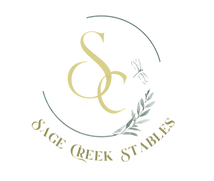The Role of Flatwork in Competitive Jumping
- Sage Creek Stables

- Jul 24
- 2 min read
Updated: Jul 26
If you ask any accomplished jumper rider the secret to success, chances are they’ll say one word: flatwork.
While the fences may be the flashiest part of show jumping, flatwork is where the real magic happens. It’s the foundation of balance, control, communication—and confidence. At Sage Creek Stables, we view flatwork not as a warm-up, but as a discipline in itself—an essential tool for both horses and riders aiming to excel in the hunter, jumper, and equitation rings.
What Is Flatwork, Really?
Flatwork refers to all the training that happens on the flat—no jumps involved. This includes transitions, lateral work, circles, lengthenings and shortenings, and everything else that improves rhythm, straightness, impulsion, and rideability.
It may seem basic, but flatwork develops the physical and mental tools that make jumping feel effortless.
Why Flatwork Matters for Jumpers
Flatwork builds the body and the brain.
It strengthens the topline and hind end
It improves balance, responsiveness, and rhythm
It sharpens transitions and enhances control
It fosters mental relaxation and physical straightness
It prevents injury by building a horse evenly and thoughtfully
Jumping is just a test of the flatwork you’ve put in. A horse that is soft, adjustable, and listening on the flat is one that will jump cleanly, confidently, and safely.
Translating Flatwork to the Jump Course
Let’s say your horse bulges on the left lead, rushes fences, or lands disunited. These aren’t jumping issues—they’re flatwork issues showing up mid-course.
That’s why we address things like:
Straightness before, over, and after the jump
Rideability between fences
Quality of the canter stride (rhythm + balance)
Correct use of aids
Effective half-halts, transitions, and bend control
By using thoughtful flatwork, we create athletes who can think, listen, and adjust mid-course—hallmarks of a successful round.
Our Flatwork Philosophy at Sage Creek
At Sage Creek, we don’t separate jumping from flatwork. Every session—whether poles, no-stirrups, or full courses—emphasizes the same core goals: balance, strength, and connection.
We approach flatwork as:
🔹 A diagnostic tool (What’s missing today?) 🔹 A way to condition both body and brain 🔹 An opportunity to develop feel and finesse 🔹 A language both horse and rider can rely on under pressure
Tips to Improve Your Flatwork
Whether you’re showing at the A-circuit or building basics, here’s what we recommend:
Ride transitions like they matter. Smooth, prompt transitions build strength and balance.
Don’t avoid lateral work. Leg yields, shoulder-in, and haunches-in improve straightness and control.
Change it up. Ride in different patterns, use poles, ride without stirrups, or try ride-and-review exercises.
Ask questions. Use your flat to ask, “Is my horse soft? Responsive? Straight? Connected?”
Prioritize feel over flash. A connected 20m circle is worth more than a rushed course.
Final Thoughts
Flatwork is not the boring part of training—it’s the part that makes everything else possible. The strongest jump rounds begin long before the warm-up ring.
At Sage Creek Stables, we treat flatwork as an artform—one that empowers riders, builds confidence in horses, and creates lasting improvement in performance. Master the flat, and the fences will follow.
Ready to Elevate Your Ride? Schedule a consultation to learn how our training program builds jumpers from the flat up. Come visit us in Bell Canyon and see how we train for excellence—one transition at a time.




Comments